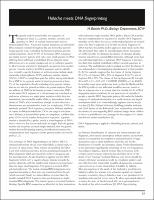Please use this identifier to cite or link to this item:
https://hdl.handle.net/20.500.12202/8920Full metadata record
| DC Field | Value | Language |
|---|---|---|
| dc.contributor.author | Babich, Harvey | - |
| dc.date.accessioned | 2023-05-22T21:16:48Z | - |
| dc.date.available | 2023-05-22T21:16:48Z | - |
| dc.date.issued | 2015 | - |
| dc.identifier.citation | Babich, H. (2014-2015). Halacha meets DNA fingerprinting. Derech HaTeva, 19, 55-59. | en_US |
| dc.identifier.uri | https://hdl.handle.net/20.500.12202/8920 | - |
| dc.description | Scientific article | en_US |
| dc.description.abstract | The genetic code is stored within the sequences of nitrogenous bases (i.e., adenine, thymine, cytosine, and guanine) on DNA of nuclear chromosomes and on mitochondrial DNA. Except for isolated mutations, an individual’s DNA remains constant throughout life and forms that person’s unique genetic code, controlling biochemical reactions, growth, and development. About 99.9% of the human DNA sequences are similar in every person, with only a very small amount of DNA differing from individual to individual. These relatively minor differences serve as genetic markers and are of sufficient quantity to allow forensic scientists to distinguish one person from another person. Genetic markers, the DNA sequences used to identify (i.e., to mark) a specific location on a chromosome, include single nucleotide polymorphisms (SNPs) and copy number variants (CNVs). A SNP is a single base pair that differs among individuals. For a SNP to be a genetic marker it must be present in at least 1% of the population, thereby excluding those genetic variants that are too rare for general usefulness in genetic analyses. There are millions of SNPs in the human genome. Consecutive SNPs on the same DNA sequence of a chromosome are correlated, as each arose in history as a single point mutation which then was transmitted, surrounded by earlier SNPs, to descendants. Such a cluster of SNPs, when located near enough to each other on a chromosome, are transmitted as a unit (or, a haplotype). CNVs are tandemly repeated DNA sequences, present in different numbers of copies in different individuals. CNVs can range in size from one a kilobase, a thousand base pairs, to a megabase, a million base pairs. CNVs vary in number from person to person. A genetic marker is identified by a probe, usually a short fragment of DNA that is a few or a few dozen nucleotides in length. Both the genetic marker and the probe are made single-stranded, with the genetic marker detected by pairing (termed, hybridization) between the complementar | en_US |
| dc.description.sponsorship | We would also like to thank the following donors who have helped fund the publication of volume 19 of Derech HaTeva. Thank you for making this opportunity possible. Dr. and Mrs. Harvey Babich Mr. and Mrs. Samuel Koslowsky Dr. and Dr. Fred Grunseid Mr. and Mrs. Morris Rosenthal Dr. and Mrs. Richard Schwimmer Rabbi and Mrs. Baruch Solnica Dr. and Mrs. Moshe Steier Dr. and Dr. Howard Weintraub Torah Activities Council YU Undergraduate Admissions | en_US |
| dc.language.iso | en_US | en_US |
| dc.publisher | Stern College for Women, Yeshiva University | en_US |
| dc.relation.ispartofseries | Derech HaTeva;Vol. 19 ; 2014-2015 | - |
| dc.rights | Attribution-NonCommercial-NoDerivs 3.0 United States | * |
| dc.rights.uri | http://creativecommons.org/licenses/by-nc-nd/3.0/us/ | * |
| dc.subject | DNA | en_US |
| dc.subject | chromosomes | en_US |
| dc.subject | DNA sequences | en_US |
| dc.title | Halacha meets DNA fingerprinting | en_US |
| dc.type | Article | en_US |
| local.yu.facultypage | https://www.yu.edu/faculty/pages/babich-harvey | en_US |
| Appears in Collections: | Stern College for Women -- Faculty Publications | |
Files in This Item:
| File | Description | Size | Format | |
|---|---|---|---|---|
| Babich Halachic meets DNA DT v9 2014-2015 55-59.pdf | 182.67 kB | Adobe PDF |  View/Open |
This item is licensed under a Creative Commons License

